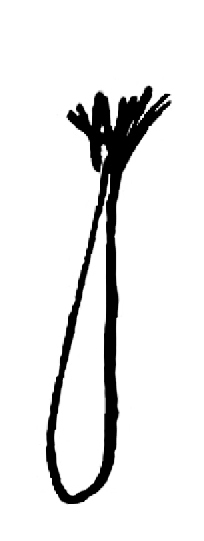From William Henry Harvey 19 May 1864
Trin. Coll | Dublin
19 May 1864
Dear Darwin
When I was out with my class1, on Saturday last, I noticed, on sandy, dry ground near the sea, a space covered by many dwarfed plants of the common Dandelion—& among them one plant to which I was attracted by the colour of its flowers. The ligules, instead of being of the common yellow, were of a deep fulvous or brownish-orange. On examining it closer I found that the achenes, in all the many flower heads which the plant bore, had changed their form “generically”—as it would be considered by any dealer in Compositæ. I send you some heads2, where you will find

|
for |

|
!!— |
Now what is this?— Is this solitary plant the sole survivor, as it ought to be by theory, of an innumerable number of infinitessimal alterations for the better, in the Achene—: or is it a sudden jump—from one sort of achene to another?
I vote for the latter opinion—seeing it is a single individual, out of hundreds observed—(we did not find another like it, though we looked all about)
But what then?— Of course, being in Ireland, it can only be a sport of a Dandelion—but if it came from S. Africa, it would be a genus.— I know several Cape Composites which can only be distinguished even specifically, by their achenes—yet these are so different, that they are placed in different genera.3
Do these generic differences occur by sudden jumps; and specific by gradual fluxions; or what?— I have always been against tying Nature down to any one mode of producing changes.4
I shall be glad to hear what you think5—& I do most sincerely hope that your health has improved
Yours very truly | W. H. Harvey
I have transferred the root, for culture, to our Botanic Garden.6 W H H
CD annotations
Footnotes
Bibliography
Correspondence: The correspondence of Charles Darwin. Edited by Frederick Burkhardt et al. 29 vols to date. Cambridge: Cambridge University Press. 1985–.
DNB: Dictionary of national biography. Edited by Leslie Stephen and Sidney Lee. 63 vols. and 2 supplements (6 vols.). London: Smith, Elder & Co. 1885–1912. Dictionary of national biography 1912–90. Edited by H. W. C. Davis et al. 9 vols. London: Oxford University Press. 1927–96.
Flora Capensis: Flora Capensis: being a systematic description of the plants of the Cape Colony, Caffraria & Port Natal, and neighbouring territories. Vols. 1–3 by William Henry Harvey and Otto Wilhelm Sonder; vols. 4–7 edited by William Turner Thiselton-Dyer; vol. 5 sect. II and supplement edited by Arthur William Hill. 7 vols. and supplement. London: L. Reeve and Co. 1860–1933.
Harvey, William Henry. 1859–63. Thesaurus Capensis: or, illustrations of the South African flora, being figures and brief descriptions of South African plants selected from the Dublin University Herbarium. 2 vols. in 1. Dublin: Hodges, Smith & Co. London: John van Voorst.
LL: The life and letters of Charles Darwin, including an autobiographical chapter. Edited by Francis Darwin. 3 vols. London: John Murray. 1887–8.
Origin: On the origin of species by means of natural selection, or the preservation of favoured races in the struggle for life. By Charles Darwin. London: John Murray. 1859.
Praeger, Robert Lloyd. 1913. William Henry Harvey 1811–1866. In Makers of British botany. A collection of biographies by living botanists, edited by Francis Wall Oliver. Cambridge: Cambridge University Press.
Variation: The variation of animals and plants under domestication. By Charles Darwin. 2 vols. London: John Murray. 1868.
Summary
Sends dandelion [enclosed] with peculiar form of achene; suggests this solitary "sport" must have arisen by sudden jump from normal type.
Letter details
- Letter no.
- DCP-LETT-4503
- From
- William Henry Harvey
- To
- Charles Robert Darwin
- Sent from
- Trinity College, Dublin
- Source of text
- DAR 166: 116
- Physical description
- ALS 4pp, encl †
Please cite as
Darwin Correspondence Project, “Letter no. 4503,” accessed on 23 April 2024, https://www.darwinproject.ac.uk/letter/?docId=letters/DCP-LETT-4503.xml
Also published in The Correspondence of Charles Darwin, vol. 12


